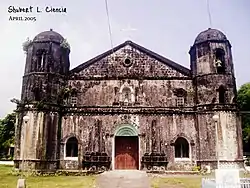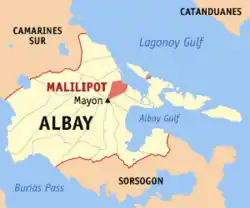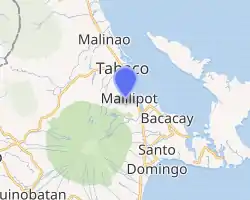Malilipot
Malilipot, officially the Municipality of Malilipot (Central Bicolano: Banwaan kan Malilipot; Tagalog: Bayan ng Malilipot), is a 4th class municipality in the province of Albay, Philippines. According to the 2015 census, it has a population of 37,785 people. [3]
Malilipot | |
|---|---|
| Municipality of Malilipot | |
 Our Lady of Mount Carmel Church in Malilipot | |
 Map of Albay with Malilipot highlighted | |
OpenStreetMap 
| |
.svg.png.webp) Malilipot Location within the Philippines | |
| Coordinates: 13°19′N 123°44′E | |
| Country | |
| Region | Bicol Region (Region V) |
| Province | Albay |
| District | 1st district |
| Barangays | 18 (see Barangays) |
| Government | |
| • Type | Sangguniang Bayan |
| • Mayor | Roli B. Volante |
| • Vice Mayor | Rolando B. Volante |
| • Representative | Edcel C. Lagman |
| • Electorate | 28,411 voters (2019) |
| Area | |
| • Total | 44.13 km2 (17.04 sq mi) |
| Elevation | 128 m (420 ft) |
| Population | |
| • Total | 37,785 |
| • Density | 860/km2 (2,200/sq mi) |
| • Households | 8,059 |
| Economy | |
| • Income class | 4th municipal income class |
| • Poverty incidence | 20.32% (2015)[4] |
| • Revenue | ₱102,759,630.02 (2016) |
| Time zone | UTC+8 (PST) |
| ZIP code | 4510 |
| PSGC | |
| IDD : area code | +63 (0)52 |
| Climate type | tropical rainforest climate |
| Native languages | Central Bikol Albay Bikol Tagalog |
History
Malilipot traces its history to the expedition of Juan de Salcedo in 1573 and the colonization of Albay Bay, now called Albay, with 120 soldiers and guides. During these period, towns were established. Libon was founded in 1573, Polangui in 1589, Oas in 1587, and Malinao in 1600. Other municipalities were established in succession. A story alleged that the Spanish colonizers reached this new settlement in the month of December. The weather was so cold that the Spaniards exclaimed "muy frio" which the natives interpreted as "Malilipot" meaning "very cold".
Another story alleged that when a Spanish ship disembarked on the bay of Malilipot, Spaniards asked a native fishermen for the name of the place. Due to language barrier, the natives thought he was asked what are their conditions, to which they replied "nalilipot kami". The Spaniards then conclude that the place was "Malilipot".
Another legendary name given to the town was "Manlipod" meaning "Protector" attributed to the mountain ranges which had protected the town from the early destructive eruptions of Mayon Volcano. It was said that, had it not been for these mountain ranges, the poblacion would have been buried under the molten lava and ashes emitted by Mount Mayon. These protective mountains are Toktokan and Bulawan (meaning "gold") situated on the southern part and extends to the western side of the town, and screens it from the ravages of Mayon Volcano. The town is popularly known as Malilipot. Now, the official name of the town is Malilipot (Ma-li-li-pot), accented on the third syllable.
Geography
Malilipot is located at 13°19′N 123°44′E.
According to the Philippine Statistics Authority, the municipality has a land area of 44.13 square kilometres (17.04 sq mi) [2] constituting 1.71% of the 2,575.77-square-kilometre- (994.51 sq mi) total area of Albay.
Barangays
Malilipot is politically subdivided into 18 barangays.[5]
The sitios of Calbayog and Canaway were converted into a barrios in 1959 and 1957, respectively.[6][7]
| PSGC | Barangay | Population | ±% p.a. | |||
|---|---|---|---|---|---|---|
| 2015 [3] | 2010 [8] | |||||
| 050509004 | Barangay I (Poblacion) | 5.7% | 2,152 | 2,075 | 0.70% | |
| 050509005 | Barangay II (Poblacion) | 1.6% | 597 | 540 | 1.93% | |
| 050509006 | Barangay III (Poblacion) | 3.4% | 1,295 | 1,164 | 2.05% | |
| 050509007 | Barangay IV (Poblacion) | 4.3% | 1,614 | 1,524 | 1.10% | |
| 050509008 | Barangay V (Poblacion) | 3.3% | 1,264 | 1,122 | 2.29% | |
| 050509001 | Binitayan | 4.9% | 1,834 | 1,654 | 1.99% | |
| 050509002 | Calbayog | 5.5% | 2,094 | 2,029 | 0.60% | |
| 050509003 | Canaway | 6.9% | 2,599 | 2,425 | 1.33% | |
| 050509009 | Salvacion | 3.1% | 1,176 | 1,220 | −0.70% | |
| 050509010 | San Antonio Santicon (Poblacion) | 2.1% | 791 | 762 | 0.71% | |
| 050509011 | San Antonio Sulong | 2.1% | 794 | 792 | 0.05% | |
| 050509012 | San Francisco | 4.1% | 1,565 | 1,476 | 1.12% | |
| 050509013 | San Isidro Ilawod | 9.8% | 3,705 | 3,528 | 0.94% | |
| 050509014 | San Isidro Iraya | 12.4% | 4,686 | 4,330 | 1.52% | |
| 050509015 | San Jose | 13.5% | 5,110 | 4,715 | 1.54% | |
| 050509016 | San Roque | 6.0% | 2,277 | 2,047 | 2.05% | |
| 050509017 | Santa Cruz | 4.4% | 1,659 | 1,599 | 0.70% | |
| 050509018 | Santa Teresa | 6.8% | 2,573 | 2,565 | 0.06% | |
| Total | 37,785 | 35,567 | 1.16% | |||
Demographics
| Year | Pop. | ±% p.a. |
|---|---|---|
| 1903 | 5,501 | — |
| 1918 | 7,272 | +1.88% |
| 1939 | 8,525 | +0.76% |
| 1948 | 9,971 | +1.76% |
| 1960 | 13,076 | +2.28% |
| 1970 | 17,455 | +2.93% |
| 1975 | 20,497 | +3.27% |
| 1980 | 23,238 | +2.54% |
| 1990 | 24,160 | +0.39% |
| 1995 | 26,834 | +1.99% |
| 2000 | 29,541 | +2.08% |
| 2007 | 33,593 | +1.79% |
| 2010 | 35,567 | +2.10% |
| 2015 | 37,785 | +1.16% |
| Source: Philippine Statistics Authority [3] [8] [9][10] | ||
In the 2015 census, Malilipot had a population of 37,785. [3] The population density was 860 inhabitants per square kilometre (2,200/sq mi).
Climate
| Climate data for Malilipot, Albay | |||||||||||||
|---|---|---|---|---|---|---|---|---|---|---|---|---|---|
| Month | Jan | Feb | Mar | Apr | May | Jun | Jul | Aug | Sep | Oct | Nov | Dec | Year |
| Average high °C (°F) | 26 (79) |
27 (81) |
28 (82) |
30 (86) |
31 (88) |
30 (86) |
29 (84) |
29 (84) |
29 (84) |
29 (84) |
28 (82) |
27 (81) |
29 (83) |
| Average low °C (°F) | 22 (72) |
22 (72) |
23 (73) |
24 (75) |
25 (77) |
25 (77) |
25 (77) |
25 (77) |
25 (77) |
24 (75) |
24 (75) |
23 (73) |
24 (75) |
| Average precipitation mm (inches) | 138 (5.4) |
83 (3.3) |
74 (2.9) |
50 (2.0) |
108 (4.3) |
165 (6.5) |
202 (8.0) |
165 (6.5) |
190 (7.5) |
186 (7.3) |
188 (7.4) |
183 (7.2) |
1,732 (68.3) |
| Average rainy days | 16.8 | 11.9 | 13.5 | 13.8 | 20.5 | 25.2 | 27.4 | 26.2 | 26.1 | 24.7 | 20.7 | 18.5 | 245.3 |
| Source: Meteoblue [11] | |||||||||||||
Attractions
"For lovers of waterfalls in more or less unspoiled nature a day trip from Legaspi to Malilipot can be warmly recommended. From here, on the north-east foothills of Mayon, there is a path leading in the direction of the volcano to the Busay Falls. These falls descend in stages from a height of 250 meters, flowing into seven pools on the way that tempt you to swim in them. If you don't want to jump straight into the first pool, then turn off onto the path on the right just before it. After about a 15-minute this will take you to the second pool."[12]
References
- Municipality of Malilipot | (DILG)
- "Province: Albay". PSGC Interactive. Quezon City, Philippines: Philippine Statistics Authority. Retrieved 12 November 2016.
- Census of Population (2015). "Region V (Bicol Region)". Total Population by Province, City, Municipality and Barangay. PSA. Retrieved 20 June 2016.
- "PSA releases the 2015 Municipal and City Level Poverty Estimates". Quezon City, Philippines. Retrieved 1 January 2020.
- "Municipal: Malilipot". PSGC Interactive. Quezon City, Philippines: Philippine Statistics Authority. Retrieved 8 January 2016.
- "Republic Act No. 2524; An Act Converting the Sitio of Calbayog, Municipality of Malilipot, Province of Albay, into a Barrio of Said Municipality". The Corpus Juris. 21 June 1959. Archived from the original on 24 October 2016. Retrieved 24 October 2016.
- "Republic Act No. 1640; An Act to Convert the Sitio of Canaway in the Municipality of Malilipot, Province of Albay, into a Barrio". The Corpus Juris. 20 June 1957. Archived from the original on 19 January 2021. Retrieved 24 October 2016.
- Census of Population and Housing (2010). "Region V (Bicol Region)". Total Population by Province, City, Municipality and Barangay. NSO. Retrieved 29 June 2016.
- Censuses of Population (1903–2007). "Region V (Bicol Region)". Table 1. Population Enumerated in Various Censuses by Province/Highly Urbanized City: 1903 to 2007. NSO.
- "Province of Albay". Municipality Population Data. Local Water Utilities Administration Research Division. Retrieved 17 December 2016.
- "Malilipot, Albay : Average Temperatures and Rainfall". Meteoblue. Retrieved 29 December 2018.
- Peters, Jens. Philippines a travel survival kit. Australia: Lonely Planet, 1996